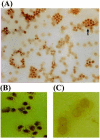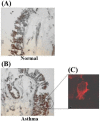STAT6 expression in T cells, alveolar macrophages and bronchial biopsies of normal and asthmatic subjects
- PMID: 22401596
- PMCID: PMC3364916
- DOI: 10.1186/1476-9255-9-5
STAT6 expression in T cells, alveolar macrophages and bronchial biopsies of normal and asthmatic subjects
Abstract
Background: Asthma is characterised by increased numbers of Th2-like cells in the airways and IgE secretion. Generation of Th2 cells requires interleukin (IL)-4 and IL-13 acting through their specific receptors and activating the transcription factor, signal transducer and activator of transcription 6 (STAT6). STAT6 knockout mice fail to produce IgE, airway hyperresponsiveness and bronchoalveolar lavage eosinophilia after allergen sensitisation, suggesting a critical role for STAT6 in allergic responses.
Methods: We have investigated the expression of STAT6 in peripheral blood T-lymphocytes, alveolar macrophages and bronchial biopsies from 17 normal subjects and 18 mild-moderate steroid-naïve stable asthmatic patients.
Results: STAT6 expression was variable and was detected in T-lymphocytes, macrophages and bronchial epithelial cells from all subjects with no difference between normal and stable asthmatic subjects.
Conclusions: STAT6 expression in different cells suggests that it may be important in regulating the expression of not only Th2-like cytokines in T cells of man, but may also regulate STAT-inducible genes in alveolar macrophages and airway epithelial cells.
Figures





Similar articles
-
The failure of STAT6-deficient mice to develop airway eosinophilia and airway hyperresponsiveness is overcome by interleukin-5.Am J Respir Crit Care Med. 1999 Oct;160(4):1283-91. doi: 10.1164/ajrccm.160.4.9809065. Am J Respir Crit Care Med. 1999. PMID: 10508820
-
Adoptive transfer of T cells induces airway hyperresponsiveness independently of airway eosinophilia but in a signal transducer and activator of transcription 6-dependent manner.J Allergy Clin Immunol. 2002 May;109(5):810-6. doi: 10.1067/mai.2002.123531. J Allergy Clin Immunol. 2002. PMID: 11994705
-
STAT6 deficiency in a mouse model of allergen-induced airways inflammation abolishes eosinophilia but induces infiltration of CD8+ T cells.Clin Exp Allergy. 1999 Jan;29(1):114-23. doi: 10.1046/j.1365-2222.1999.00405.x. Clin Exp Allergy. 1999. PMID: 10051710
-
IL-5 and IL-5 receptor in asthma.Mem Inst Oswaldo Cruz. 1997;92 Suppl 2:75-91. doi: 10.1590/s0074-02761997000800012. Mem Inst Oswaldo Cruz. 1997. PMID: 9698919 Review.
-
The pathobiology of bronchial asthma.Adv Immunol. 1992;51:323-82. doi: 10.1016/s0065-2776(08)60491-5. Adv Immunol. 1992. PMID: 1502977 Review.
Cited by
-
Anti-inflammatory potential of PI3Kδ and JAK inhibitors in asthma patients.Respir Res. 2016 Oct 4;17(1):124. doi: 10.1186/s12931-016-0436-2. Respir Res. 2016. PMID: 27716212 Free PMC article.
-
Banhahubak-Tang Tablet, a Standardized Medicine Attenuates Allergic Asthma via Inhibition of Janus Kinase 1 (JAK1)/ Signal Transducer and Activator of Transcription 6 (STAT6) Signal Pathway.Molecules. 2020 May 8;25(9):2206. doi: 10.3390/molecules25092206. Molecules. 2020. PMID: 32397290 Free PMC article.
-
STAT6 and lung inflammation.JAKSTAT. 2013 Oct 1;2(4):e25301. doi: 10.4161/jkst.25301. Epub 2013 Jun 10. JAKSTAT. 2013. PMID: 24416647 Free PMC article. Review.
-
Elevated H3K18 acetylation in airway epithelial cells of asthmatic subjects.Respir Res. 2015 Aug 5;16(1):95. doi: 10.1186/s12931-015-0254-y. Respir Res. 2015. PMID: 26243279 Free PMC article.
-
New drugs targeting Th2 lymphocytes in asthma.J Occup Med Toxicol. 2008 Feb 27;3 Suppl 1(Suppl 1):S6. doi: 10.1186/1745-6673-3-S1-S6. J Occup Med Toxicol. 2008. PMID: 18315837 Free PMC article.
References
-
- Barnes PJ, Chung KF, Page CP. Inflammatory mediators of asthma: an update. Pharmacol Rev. 1998;50:515–596. - PubMed
-
- Hart L, Lim S, Adcock I, Barnes PJ, Chung KF. Effects of inhaled corticosteroid therapy on expression and DNA-binding activity of nuclear factor kappaB in asthma. Am J Respir Crit Care Med. 2000;161:224–231. - PubMed
-
- Hart LA, Krishnan VL, Adcock IM, Barnes PJ, Chung KF. Activation and localization of transcription factor, nuclear factor-kappaB, in asthma. Am J Respir Crit Care Med. 1998;158:1585–1592. - PubMed
-
- Demoly P, Basset SN, Chanez P. et al.c-fos proto-oncogene expression in bronchial biopsies of asthmatics. Am J Respir Cell Mol Biol. 1992;7:128–133. - PubMed
-
- Annunziato F, Galli G, Cosmi L, Romagnani P, Manetti R, Maggi E, Romagnani S. Molecules associated with human Th1 or Th2 cells. Eur Cytokine Netw. 1998;9:12–16. - PubMed
Grants and funding
LinkOut - more resources
Full Text Sources
Research Materials
Miscellaneous

